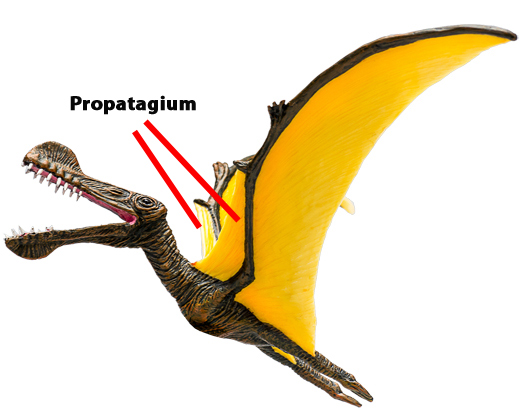New Study Suggests Some Theropod Dinosaurs Had a Propatagium
New research suggests maniraptoran theropod dinosaurs possessed a propatagium. The propatagium (pronounced pro-pah-ta-gee-um), is a soft tissue structure that joins the wrists and shoulders of volant birds. It helps with the wing flapping motion and provides a leading edge to the wing. Without this structure, birds could not fly.
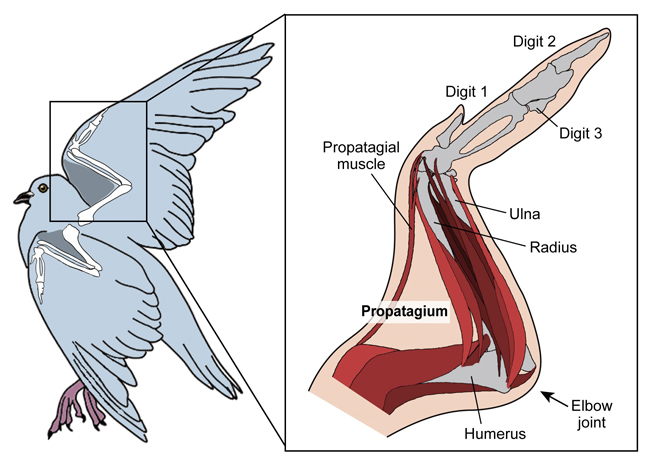
Propatagia in Maniraptoran Dinosaurs
If members of the Maniraptora, such as Therizinosaurus, Velociraptor, Oviraptor and troodontids had a propatagium on each arm, this would change how these dinosaurs are depicted. Many existing models and replicas would not be accurate and these figures would require updating.
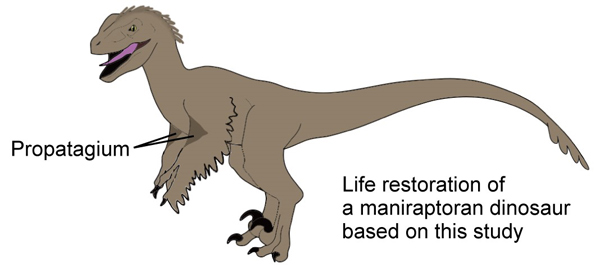
The Propatagium
Modern volant birds have a propatagium. A specialised wing structure, without which they would not be able to fly. The evolutionary origins of the propatagium remain uncertain, but new research led by scientists at the University of Tokyo (Japan), is helping to fill some of the gaps. By conducting a statistical analysis of the arm joints associated with the fossilised remains of some dinosaurs, the researchers have concluded that a propatagium was present in certain theropod dinosaurs on the dinosaur/bird evolutionary lineage.
Propatagia are also known in other volant vertebrates – the bats and pterosaurs. These structures are examples of convergent evolution. Anatomical traits arising as animals adapt in similar ways to similar selective pressures.
Birds Evolved from Dinosaurs
Most scientists agree that birds evolved from maniraptoran dinosaurs. It therefore seems appropriate to look for avian traits within the Dinosauria, such as the presence of feathers, strong but light bones, and inner ears that help with balance and spatial awareness.
The University of Tokyo’s Department of Earth and Planetary Science wanted to try to see if evidence for the propatagium could be found in the non-avian dinosaur fossil record. The propatagium contains a muscle which connects the wrist to the shoulder and the research team set about trying to find evidence for this soft tissue structure in the fossilised remains of maniraptoran dinosaurs.
Co-author of the paper, published in the journal “Zoological Letters”, Associate Professor Tatsuya Hirasawa explained:
“It [the propatagium] is not found in other vertebrates, and it’s also found to have disappeared or lost its function in flightless birds, one of the reasons we know it’s essential for flight. So, in order to understand how flight evolved in birds, we must know how the propatagium evolved. This is what prompted us to explore some distant ancestors of modern birds, theropod dinosaurs.”
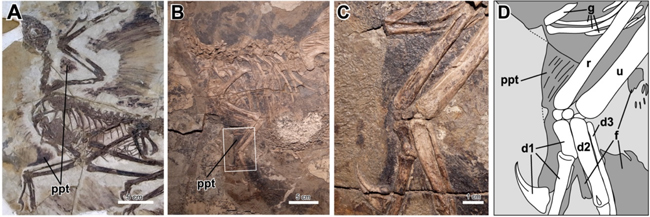
Studying Theropod Dinosaurs
Theropod dinosaurs such as Giganotosaurus, Tyrannosaurus rex and Velociraptor had arms, not wings, although some theropods such as the dromaeosaurid Microraptor were capable of flight. If the researchers could find evidence of early examples of the propatagium within non-avian dinosaurs, they would gain a better understanding of how some Dinosauria gradually transitioned from having arms to evolving wings.
Unfortunately, a soft tissue structure such as a propatagium would only be preserved in exceptional circumstances. Hard, mineralised parts of the body such as bones have a far greater fossilisation potential. Perhaps the bones of fossilised dinosaurs could provide a clue?
Co-author of the study, Yurika Uno (University of Tokyo) explained:
“The solution we came up with to assess the presence of a propatagium was to collect data about the angles of joints along the arm, or wing, of a dinosaur or bird.”
Studying Joint Angles
The presence or lack of a propatagium could be inferred by examining the angles of the joints in the arm in articulated fossil specimens. The way arm joints are articulated in fossils gives away the presence or absence of the propatagium structure. Thus the researchers could provide indirect evidence demonstrating the evolution of the avian wing structure.
The graduate student added:
“In modern birds, the wings cannot fully extend due to the propatagium, constraining the range of angles possible between connecting sections. If we could find a similarly specific set of angles between joints in dinosaur specimens, we can be fairly sure they too possessed a propatagium. And through quantitative analyses of the fossilised postures of birds and nondinosaurs, we found the tell-tale ranges of joint angles we hoped to.”
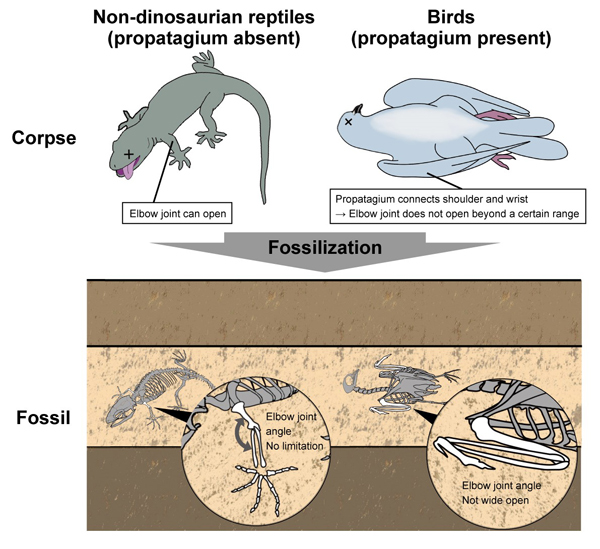
A Focus on the Maniraptora
The researchers postulate that the propatagium likely evolved in a group of dinosaurs known as the maniraptoran theropods. The Maniraptora clade is composed of coelurosaurian dinosaurs and is defined as including all birds and the non-avian dinosaurs that were more closely related to birds than they were to Ornithomimus velox.
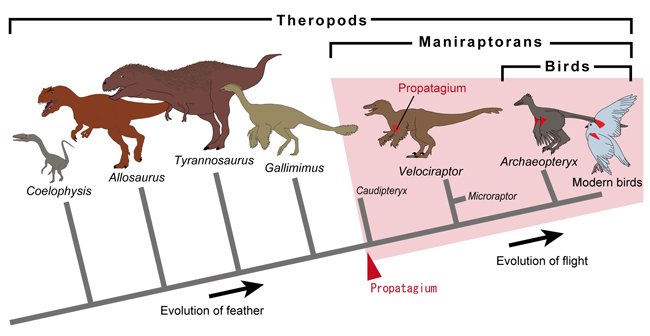
Close examination of the fossilised remains of the oviraptorosaurian Caudipteryx and the winged dromaeosaurian Microraptor indicate the presence of propatagia. The researchers suggest that they have found evidence for the presence of a propatagium in dinosaurs that existed prior to the evolution of flight in the maniraptoran lineage.
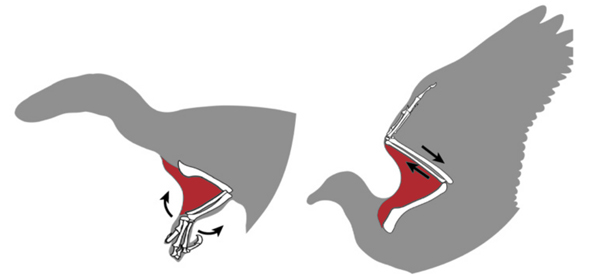
Why Did the Propatagium Evolve?
If maniraptoran dinosaurs had propatagia prior to the evolution of powered flight, then this raises an intriguing question. Why did the propatagium evolve? Why did these particular theropods evolve such a structure?
The University of Tokyo researchers are optimistic that by studying more fossils as well as embryonic development within extant vertebrates they might be able to provide some answers.
The team thinks some theropods might have evolved the propatagium not because of any pressure to learn to fly, as their forelimbs were made for grasping objects and not for flying. The propatagium originally had another purpose. It could be speculated that this “leading edge” of the arm evolved to help amplify visual intraspecific communication. Perhaps it evolved as a soft tissue structure used in display to demonstrate fitness for breeding and to win mates.
An enlarged surface area of the forelimb might have played a role in helping to shade eggs or perhaps play some other role in the brooding process.
Finding fossil evidence to support these suggestions is likely to prove difficult. However, if further studies demonstrate the presence of propatagia in the Maniraptora, it will change the way these types of dinosaurs are depicted.
Everything Dinosaur acknowledges the assistance of a media release from the University of Tokyo in the compilation of this article.
The scientific paper “Origin of the propatagium in non-avian dinosaurs” by Yurika Uno and Tatsuya Hirasawa published in Zoological Letters


